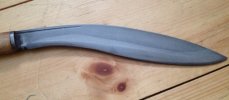Basic DIY Parkerizing Formula
- 2 gallons of distilled water
- 2 “biscuits” of clean 0000 steel wool
- 1 cup of Klean Strip brand Phosphoric Prep & Etch (or other phosphoric acid etching solution around 35-45% concentrate per the Prep & Etch MSDS sheet)
- 6 rounded tablespoons of manganese dioxide (available at pottery supply stores or eBay, which is where I bought mine)
Do this outside - never in your house or shop (unless you have a great vent hood)
Add acid to water in a stainless pan/pot and heat to 190F - don't boil and waste it. I use a baking thermometer clipped to the side of the pan.
As the solution warms shred the steel wool into the liquid and add the manganese dioxide
Let the mix sit and dissolve the steel wool before adding parts
I always blast my parts before I parkerize them - I've heard guys tell about using a wire brush on a buffer or drill press as well but I've not tried that.
Make sure your parts are very, very clean - degreased and only handle with rubber gloves after
You can suspend your parts in the liqud with stainless wire. Leave them until the fizzing stops or about 30-40 minutes. The time varies.
Rinse the parts with boiling water thoroughly to remove the acid.
Spray parts with WD40 to get the water away from the steel
Wipe down with oil or apply whatever secondary finish you want
When you are done, let your mixture cool and strain the liquid through a coffee filter into a plastic can for future use.
The white precipitate is toxic. Allow it to air dry and dispose of following your area's hazardous waste guidelines.







